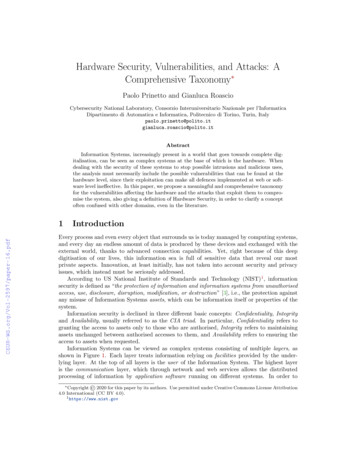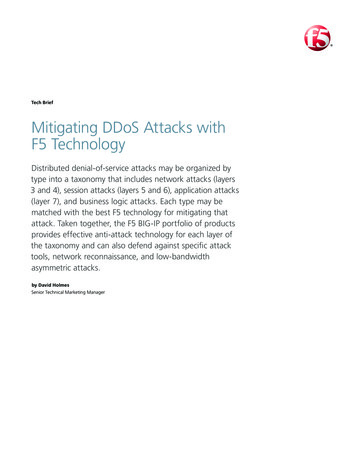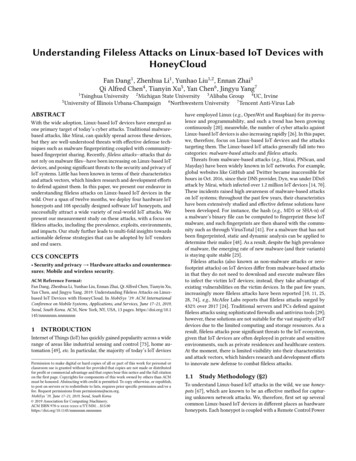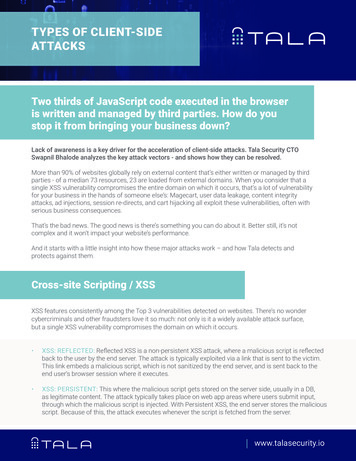
Transcription
Hardware Security, Vulnerabilities, and Attacks: AComprehensive Taxonomy Paolo Prinetto and Gianluca RoascioCybersecurity National Laboratory, Consorzio Interuniversitario Nazionale per l’InformaticaDipartimento di Automatica e Informatica, Politecnico di Torino, Turin, to.itAbstractInformation Systems, increasingly present in a world that goes towards complete digitalisation, can be seen as complex systems at the base of which is the hardware. Whendealing with the security of these systems to stop possible intrusions and malicious uses,the analysis must necessarily include the possible vulnerabilities that can be found at thehardware level, since their exploitation can make all defences implemented at web or software level ineffective. In this paper, we propose a meaningful and comprehensive taxonomyfor the vulnerabilities affecting the hardware and the attacks that exploit them to compromise the system, also giving a definition of Hardware Security, in order to clarify a conceptoften confused with other domains, even in the literature.1IntroductionEvery process and even every object that surrounds us is today managed by computing systems,and every day an endless amount of data is produced by these devices and exchanged with theexternal world, thanks to advanced connection capabilities. Yet, right because of this deepdigitisation of our lives, this information sea is full of sensitive data that reveal our mostprivate aspects. Innovation, at least initially, has not taken into account security and privacyissues, which instead must be seriously addressed.According to US National Institute of Standards and Technology (NIST)1 , informationsecurity is defined as “the protection of information and information systems from unauthorisedaccess, use, disclosure, disruption, modification, or destruction” [3], i.e., the protection againstany misuse of Information Systems assets, which can be information itself or properties of thesystem.Information security is declined in three different basic concepts: Confidentiality, Integrityand Availability, usually referred to as the CIA triad. In particular, Confidentiality refers togranting the access to assets only to those who are authorised, Integrity refers to maintainingassets unchanged between authorised accesses to them, and Availability refers to ensuring theaccess to assets when requested.Information Systems can be viewed as complex systems consisting of multiple layers, asshown in Figure 1. Each layer treats information relying on facilities provided by the underlying layer. At the top of all layers is the user of the Information System. The highest layeris the communication layer, which through network and web services allows the distributedprocessing of information by application software running on different systems. In order to Copyright 2020 for this paper by its authors. Use permitted under Creative Commons License Attribution4.0 International (CC BY 4.0).1 https://www.nist.gov
Hardware Security, Vulnerabilities, and Attacks: A Comprehensive TaxonomyPrinetto and Roasciowork, the applications need services provided by the system software (typically the OperatingSystem), which in turn is the last virtualisation layer on top of the hardware. “Hardware” isa vague concept, being it often given different interpretations and meanings, as a consequenceof the peculiar points of view of different stakeholders, including end-users, providers, OEMs,manufacturers, designers, etc. In the sequel, the term hardware is used to collectively refer tothe whole set of electronic devices used to set-up an Information System, Information Technology (IT) or Operational Technology (OT) indifferently, regardless its complexity, its field ofapplication, and the functionality/role of the devices within it.USERWEB /COMMUNICATIONAPPLICATIONSOFTWARESYSTEM SOFTWAREHARDWAREFigure 1: Layerized view of a computing system.From the security point of view, any component of any Information System layer may haveweaknesses that can generate vulnerabilities. The MITRE Corporation2 defines a vulnerabilityas a weakness present inside a component of an information system that, “when exploited,results in a negative impact to Confidentiality, Integrity, OR Availability” [2]. Anything thatendangers at least one of the three aspects of the CIA triad makes the system vulnerable, i.e.,not completely secure.When a component of one of the layers is compromised by an attack, either the lowerlayer provides protection, and thus the intrusion is stopped, or it is compromised as well, andthe attacker can use it maliciously. It is therefore clear that the base of the layer stack, thehardware, plays a primary role in Information System security: it represents, by construction,the last line of defense against intrusions [7, Section 4.1]. Directly or indirectly being the baseall the other layers rely on, if attacked, it may render useless all the defences implemented inthe upper layers.The presence of hardware vulnerabilities has thus an obvious impact on the InformationSystem security, but this is not the only role that hardware plays in its security. We can,in fact, identify three different areas to consider, as shown in Figure 2: Hardware Security,Hardware-based Security, and Hardware Trust.Hardware Security refers to all the actions needed to (i) identify hardware vulnerabilities, (ii)analyse their effects, (iii) prevent their exploitations by mitigating, reducing, and (ideally)making null the risks induced by their presence, (iv) develop and implement protectionsand remediation solutions, and (v) possibly avoid them by proper remediations during2 https://cve.mitre.org/2
Hardware Security, Vulnerabilities, and Attacks: A Comprehensive TaxonomyPrinetto and Roasciothe design and production phases (Security-by-Design). Note that this definition is in noway constrained on where or when what described above can be done. For example, thefact that the vulnerabilities be located in the hardware and that the hardware attackstry to open breaches through them to compromise the security of the system, does notnecessarily mean that the defences against them must be implemented at the hardwarelevel. This would be extremely limiting, since most vulnerabilities are discovered oncethe hardware is already operating in the field, without the possibility of being patched, asit can mostly be done for software. Therefore, any technique aimed at counter hardwareattacks falls under the definition of Hardware Security, even if mitigations are applied atthe upper layers.Hardware-based Security refers to all the solutions aimed at resorting to hardware to protect the system from attacks that exploit vulnerabilities present in other components ofthe system.Hardware Trust refers to minimising the risks introduced by hardware counterfeiting, thusguaranteeing the other components of the system about the authenticity of the usedhardware AREHARDWARETRUSTFigure 2: The role of Hardware in Information System security.In the sequel of this paper, we shall zoom on Hardware Security, only, presenting a taxonomyof both vulnerabilities affecting the hardware and of the attacks targeting it. Section 2 contextualises the paper and shows some previous attempts to systematise the topic; then, Section 3classifies hardware vulnerabilities, Section 4 presents hardware attacks and, eventually, Section5 concludes the paper.2State of the ArtSince Information Systems began to spread and evolve, the topic of security has always beenmainly addressed in relation to the protection from intrusions made possible by their web3
Hardware Security, Vulnerabilities, and Attacks: A Comprehensive TaxonomyPrinetto and Roascioconnections, i.e., in an environment potentially open to anyone. It is therefore a fact thatnetworks and software have received the most of the attention, while hardware has traditionallybeen considered as secure and inviolable. On the other hand, the role of hardware componentsin safety and in safety-critical applications have been deeply investigated [13]: it was commonlybelieved that hardware could at most fail, but not be attacked.At the end of the last century, smart cards were already diffused. Based on chips specializedin security and authentication applications, these devices were considered impossible to crackif not with very advanced means, out of the possibility of common hackers. But starting from1996, this thesis started to be dismantled through demonstrations, for the first time, of faultinjection attacks or microprobing experiments carried out with common equipment againstthese chips [5] [6], and the problem began to be slowly acknowledged.In the same years or a little later, important authors such as Kocher [33] [32] and others [41][39] began to raise the problem of extrapolating information from secure devices such as smartcards simply by listening to the surrounding environment, e.g., by measuring the time taken,the energy consumed, the radiation emitted. Cryptographic algorithms, considered practicallyimpossible to break mathematically, are instead vulnerable in their physical implementations.This was how the so-called side-channel attacks started to be known.At the beginning of the century, the vertical integration model in the hardware supply chainwas abandoned in favor of the horizontal one: instead of taking care of all stages of production,from specifications to final manufacture, companies started to outsource manufacturing to thirdparty companies, to which the layout of their devices is delivered. Therefore, the communitystarted to reason about the possible risks of counterfeiting and piracy deriving from this, with afirst article in 2001 by Koushanfar et al. [35]. The issue was even raised years later by the UnitedStates Congress [1]. Thus, a whole literature has been produced on the so-called hardwaremetering [34] and its implementation methods, including Physical Unconable Functions (PUFs)[40] or circuit obfuscation [42]. Similarly, a manufacturing process that includes untrusted actorsstarted to raise doubts about the possibility of inclusion of hardware Trojan horses [55], i.e.,Trojans inserted directly into the circuit, to be activated once the device is put into operation.The concept of security related to hardware is therefore a young concept, and it may seemin itself a spurious union of techniques for protecting sometimes the originality and the integrityof the hardware design, sometimes the information itself treated by the hardware. Only in morerecent years, some authors have tried to tidy up by proposing examples of taxonomies, amongwhich we report here the most significant according to our opinion.In a paper of 2014, Rostami et al. [45] distinguish, within the sphere of Hardware Security,5 major issues: Hardware Trojans, Reverse Engineering of the design, Intellectual-PropertyPiracy, Side-Channel Attacks and Hardware Counterfeiting. It is a classification that confusesvulnerabilities, types of attacks and purposes of attacks, since, for example, many reverseengineering attacks are certainly performed to steal the intellectual property of a circuit, whileTrojans are to be considered rather as vulnerabilities, triggered later by an attack, but they arenot properly an attack category.In the same year, Hamdioui et al. [25] tried to classify attacks in attacks to data (e.g., Sidechannel attacks), attacks to design (e.g., reverse-engineering attacks) and attacks to functionality, with three modes in the context of attacks to data: invasive, non-invasive, or semi-invasivewith respect to the physical device itself, a very important concept that will be discussed laterin the paper.In their handbook published in 2018 [10], Bhunia and Tehranipoor well explain problemsrelated to security of hardware components with many practical examples, without much refining the taxonomy of Rostami’s 2014 article, but adding a fundamental distinction of the overall4
Hardware Security, Vulnerabilities, and Attacks: A Comprehensive TaxonomyPrinetto and Roascioproblem in two wide families: (i) attacks targeting hardware with their countermeasures, and(ii) attacks targeting the system with their hardware-based countermeasures, i.e., what we haverespectively called Hardware Security and Hardware-based Security in the previous Section.3Hardware Vulnerabilities TaxonomyThe proposed taxonomy of hardware vulnerabilities is shown in Figure 3. Vulnerabilities arefirst clustered according to their nature and their domain, in turns into different criteria.HARDWARE ckdoorflawdomainlogical physicalFigure 3: Hardware vulnerabilities taxonomy.The nature may be intentional or unintentional , i.e., the vulnerability may be introducedinto the device voluntarily or not during its design and production phases. Unintentionalvulnerabilities are further split into bugs and flaws.A bug is an inconsistency between a specification and its actual implementation, introducedby a mistake during a specific design phase which is not detected during the subsequent V&V(Validation and Verification) phase.A flaw is, instead, a non-primary feature that does not constitute an inconsistency w.r.t.the specs, and that is the result of a misconception of the designer who did not take intoconsideration its potential dangerousness. A flaw differs from a bug, being not colliding withany specification. As an example, in the design of modern microprocessors, the need to optimizeperformance through speculative execution and aggressive caching caused flaws such as thefamous Meltdown [37] and Spectre [31]: such vulnerabilities were not born by a mistake madeby the designer, but unintentionally introduced during the optimisation phase, without takinginto account the risks that those race conditions could have led to.A vulnerability inserted intentionally inside a hardware device can be referred to as a backdoor, as the person who inserts them wants to guarantee her/himself (or someone else) thepossibility of a later access or misuse that is outside the set of intended use-cases. Note thatthe presence of a backdoor exposes the hardware component to threats independently of thefact it was inserted maliciously or not. From the one hand, an example of malicious backdooris a Hardware Trojan [55], i.e., a rogue piece of circuitry inserted at a given point of the designand production phases, which can carry out unauthorised actions when its “triggering” conditions are satisfied. As already said, with the globalization of Integrated-Circuit (IC) designand manufacturing, the outsourcing of production task has become a common way to lower theproduct’s cost. Embedded hardware devices are not always produced by the companies thatdesign and sell them, nor in the same country where they will be used. A malicious intruderwith access to the manufacturing process can introduce some changes to the final product. A5
Hardware Security, Vulnerabilities, and Attacks: A Comprehensive TaxonomyPrinetto and RoascioHardware Trojan is characterized by a payload, i.e. the entire activity that the Trojan executes when it is activated, and by a trigger which is the condition verified in the state of thecircuit that activates the payload. In general, malicious Trojans try to bypass or disable thesecurity fence of a system, they can leak confidential information by radio emission or by otherside-channel signal. A Trojan can also be used to disable, derange or destroy the entire chip orcomponents of it. A Trojan can be introduced during any production step (design, fabrication,test, assembly) and at any level (register-transfer level, gate level, transistor level and evenphysical level).From the other hand, an example of non-malicious backdoors is provided by the undocumented instructions of some processors belonging to x86 family, such as the one presentedin [15]: the undocumented opcode ALTINST (0x0F3F), most likely originally introduced by thedesigners for debugging purposes, allows the user to switch to an alternative ISA (InstructionSet Architecture), closer to the actual inner RISC architecture, and it can be used maliciouslyto mount a privilege escalation attack.Orthogonally to its nature, a hardware vulnerability belongs to a domain, either logicalor physical. A hardware vulnerability is logical when it has been introduced during the earlydesign phases of the device, whereas it is physical when it is related to vulnerabilities introducedduring the latest technology-mapping steps of the design process.A typical example is here provided by the fact that a series of consecutive write operationsinto a DRAM memory cell (row hammering) can induce adjacent cells to flip their content,due to an electric leakage effects [30]. Such a vulnerability is in fact intrinsic to the technologyadopted for implementing the memory, even if an accurate analysis of the well known linkeddynamic faults in DRAM [4] [14] could suggest proper remediation at the design time.4Hardware Attacks TaxonomyFor the very meaning of the term, a vulnerability is not such if it cannot be exploited, because itwould not expose the system to any risk, so it would not constitute any weakness. The exploitis the mean or method of taking advantage of a vulnerability for malicious purposes. Therefore,a hardware attack can be defined as the act of taking advantage of a hardware vulnerability.It is important to clearly point out that an attack always happens just when the hardwareaffected by a vulnerability is operating in the field: modifying a design to introduce a backdooris a vulnerability insertion, while exploiting it is an attack.Moreover, if the presence of a vulnerability jeopardises Confidentiality, Integrity or Availability (Section 3), and if the vulnerability is such only if it is exploitable, then an attack, usingan exploit, is by definition an action that puts at risk the Confidentiality, the Integrity or theAvailability of an asset, and therefore everything that does not impact on any of these threeproperties is outside the definition of attack.The taxonomy for hardware attacks is summarised in Figure 4.A hardware attack is first classified by the goal for which it is launched. The goal is themalicious action that the attacker wants to take against an asset of the attacked hardware,defined as a target. The target can be the information that the hardware is treating, butalso a property of the hardware itself, either functional or non-functional [26]. One can launchan attack to:steal a target (e.g., a cryptographic key, a secret password, an intellectual property, a resource,etc.); referring to the CIA triad, stealing is an action carried out in violation of Confidentiality, since the attacker takes possession of an asset of which she/he does not own the6
Hardware Security, Vulnerabilities, and Attacks: A Comprehensive TaxonomyPrinetto and RoascioHARDWARE ATTACKSgoalstealcorrupt inhibittargetinformationpropertydomainlogical physicalmodalityinvasive non-invasivepassiveactiveFigure 4: Hardware attacks taxonomy.rights of access or use. It worths pointing out that the so called intellectual property (IP)theft is to be considered as a case of IP-piracy attack, and related solutions are demandedto Hardware Security. Intellectual property is in fact a full-fledged target according tothe definition given in Section 4, and therefore it should be protected exactly as any otherhardware asset;corrupt a target (e.g., a memory word, a permission file, a functionality to make it folded toone’s advantage, etc.); corrupting is an action carried out in violation of Integrity, sincethe attacker modifies an asset without being authorised to do it;inhibit a target (e.g., a service, a set of critical data, a defense mechanism, etc.); inhibitingis an action carried out in violation of Availability, since the attacker prevents an assetfrom being properly accessed or used by those who hold rights to do that.As well as vulnerabilities, hardware attacks always have a domain in which they are implemented. An attack belongs to the logical domain if it is implemented starting from upperlayers with respect to hardware (Figure 1), i.e., when a hardware vulnerability, logical or physical, is exploited through actions not directly on the hardware itself, but on the software levelsrunning on top of it. This domain includes, for example, privilege escalation attacks exploiting the row-hammer vulnerability [49] [56], or those that exploit vulnerabilities in processormicroarchitecture such as Meltdown [37], Spectre [31] or others [20] [12] [47] [28], and alsocache-based attacks [58] [48].An attack belongs instead to the physical domain if it is implemented through actionsdirectly performed on the attacked hardware device.Finally, a hardware attack is qualified depending on the modality in which it is carried out.The attack is invasive when the actions taken against the attacked hardware includes physicalintrusions such as desoldering, depackaging, disconnection of its internal components. Attackshaving this modality are, for example: Microprobing Attacks: A microprobing attack tries to extract information by measuring electrical quantities directly on the silicon die of the target device, once obtainedphysical access to it. The die exposition is usually achieved by removing the plastic packages via chemical etching and/or by mechanical approaches. When possible, attackersstudy the netlist of the target before the attack, so with little reverse engineering theyare able to find matches with the layout in order to locate connection carrying sensible7
Hardware Security, Vulnerabilities, and Attacks: A Comprehensive TaxonomyPrinetto and Roasciodata. At this point, thank to advanced equipment as Focused Ion Beam (FIB) generators,they can obstruct wires with nanometric precision, or create conductive paths that serveas electrical probe contact in a further moment. A probe equipment is then employedto read the target signals and extract information. Such sophisticated equipment seemsdifficult to obtain commonly, but for example a FIB generator can be rented for just acouple hundred dollars per hour, which is reasonable with respect to an information theftthat could be highly rewarding [50] [52]. Reverse Engineering Attacks: An attack of reverse engineering is similar to microprobing with respect to mounting phase (desoldering and decapsulation), but actuallyhas a different scope. It in fact aims at understanding the structure of a semiconductordevice and its functions, i.e., at stealing the intellectual properties of the designer. Adeep knowledge and expertise on advance IC design are obviously required to succeed.All the layers formed during chip fabrication are removed one-by-one in reverse order andphotographed to determine the internal structure of the chip. At the end, by processingall the acquired information, a standard netlist file can be created and used to simulateand eventually redesign the target device [19]. Data Remanence Attacks: Computers typically store secret data in DRAM, properlyde-powered when the device is tampered with. It is common to think that once the poweris down, the content of volatile memories is erased (this is why they are called volatile,actually). Although, it has been proved that the charge stored in a DRAM cell has a givendecay rate which is not infinitive and strictly depends on temperature. At temperaturesfrom 50 C down, the contents of RAMs can be “frozen” and kept for one or even moredays. This is what usually happens in a cold-boot attack [23] [22], in which the hackeruses spray cans or liquid nitrogen on a volatile device just disconnected from the originalsystem and gains precious time to perform a memory dump, i.e., a copy of the contents ona non-volatile device for subsequent analysis. Data remanence affects in a different waynon-volatile types of memory such as EEPROM and Flash. Some sensible informationthought to be erased can still be extracted [51].The attack is instead non-invasive when it can be carried out without any physical contactwith the device under attack. Non-invasive attacks are further split into passive and active.Passive non-invasive attacks are carried out by analysing and measuring one (or more) physicaldynamic entities of the attacked hardware. All different types of side-channel attacks [36] [54]belong to this category. Active non-invasive attacks require instead specific actions on the device, aimed at forcing the system into abnormal states in which the goal is easier to reach. Thiscategory includes all the different types of fault attacks [11] [8] and test-infrastructure-basedattacks [57] [44].Side-Channel Attacks. Being something with physical consistence, when it is in activity, thehardware unintentionally releases in the surrounding environment a certain number of “clues”,such as spent time, spent energy, electromagnetic radiation released, noise, etc. These clues,along with the knowledge of some details about the device structure or just about the executedalgorithms, may turn out to be critical for information protection. The mostly known classesof side-channel attacks are: Timing Attacks: A timing side-channel attack tries to recover sensible data by measuringtheir computation time in a piece of hardware. In most cases, the algorithm implementation strongly depends on the actual values of its input. If an attacker knows this8
Hardware Security, Vulnerabilities, and Attacks: A Comprehensive TaxonomyPrinetto and Roasciocorrelation, he can extract, for example, the encryption key or the password that is beingprocessed. Examples of timing attacks against hardware implementations of RSA [33] orAES [9] [29] have been presented in literature. Power Attacks: The actual power consumption of a programmable device depends onboth the executed instructions and the processed data. A power side-channel attack triesto read in reverse this process and to recover sensible data processed by measuring thevariation of power consumption of the hardware device [32] [53]. Electromagnetic Attacks: Whenever a current flows, an electromagnetic field is createdaround it. This radiation unintentionally carries information about the source, and byresorting to proper capturing devices, such as an induction coil, located in the proximityof the device, one can reconstruct the digital signal which originated it [59]. Acoustic Attacks: Acoustic cryptoanalysis exploits vibration produced by hardware components of every kind and at any level, from device to circuit level. Covert listeningdevices may be placed by attackers to record the sound emitted by keyboards and keypads, and then a significative amount of sensed data can be later processed by signalanalysis and/or Machine Learning algorithms to associate a particular sound-wave withthe pressed key [43] [24]. Acoustic emissions in the ultrasonic band occur in circuit elements as coils and capacitors as a consequence of the current flowing through them.Voltage regulation circuits in PC motherboards are responsible for acoustic emanationwhich are directly correlated with CPU activity [21]. Optical Attacks: Besides draining current or emitting radiation, a transistor that switchesalso emits some light in the form of a few photons for a very short time. If an attackeris able to detect such an emission, he can steel sensible information from the circuit [17].Alternatively, information-carrying light emissions can also be exploited when LEDs areemployed as device activity indicators [38].Fault Attacks. They consist in the injection of deliberate (malicious) faults into the targetdevice, aimed at bringing it into a set of states from which private internal information itemscan be fraudolently extracted. Types of fault attacks are mostly clustered according to thefault injection techniques. The most relevant are: Supply Attacks: If an attacker is able to tap into the power supply line of the target deviceand connect his power unit, he can underpower the device itself. If the power is lower, thedelay of logic gates increases and in the case of critical paths it may happen that wrongvalues are sampled; this practically implies that one, or more, faulty bits, are injected intothe system [16]. On the other hand, if a chip is overpowered, serious damaging actionscan be carried out. Clock Attacks: The length of a single cycle can be shortened through forcing a prematuretoggling of the clock signal. In this way, registered bytes can be corrupted. To alter thelength of the clock cycle, the attacker needs to get a direct control of the clock line, as ittypically happens when smart cards are targeted. As an unplanned clock edge introducesa glitch in the internal signals, these attacks are also knowns as Glitch Attacks [18]. Heating Attacks: Rising the temperature in the environment in which the target deviceoperates may be exployted to attack it. Electrons inside the transistors are excited bythe surrounding heat and random currents are generated, which may lead to bit flipping9
Hardware Security, Vulnerabilities, and Attacks: A Comprehensive TaxonomyPrinetto and Roascio(both in SRAM memory cells inside processors and in DRAM memory cells) or even toaccelerated the ageing of the circuit, with the extreme consequence of its destruction whenthe overheating reaches a given threshold [27]. Radiation Attacks: A practical way to induce faults without having to tap into the deviceis to cause strong electromagnetic disturbances near it. The eddy currents induced in thecircuit by strong EM pulses cause temporary alterations of the level of a signal, whichmay be, for example, recorded by a latch or a flip-flop. When the disturbance becomeshigher and higher, components of the device may stop working or even be physicallydestroyed [46].Test-Infras
System security, but this is not the only role that hardware plays in its security. We can, in fact, identify three di erent areas to consider, as shown in Figure2: Hardware Security, Hardware-based Security, and Hardware Trust. Hardware Security refers to all the actions needed to (i) identify hardware vulnerabilities, (ii)










